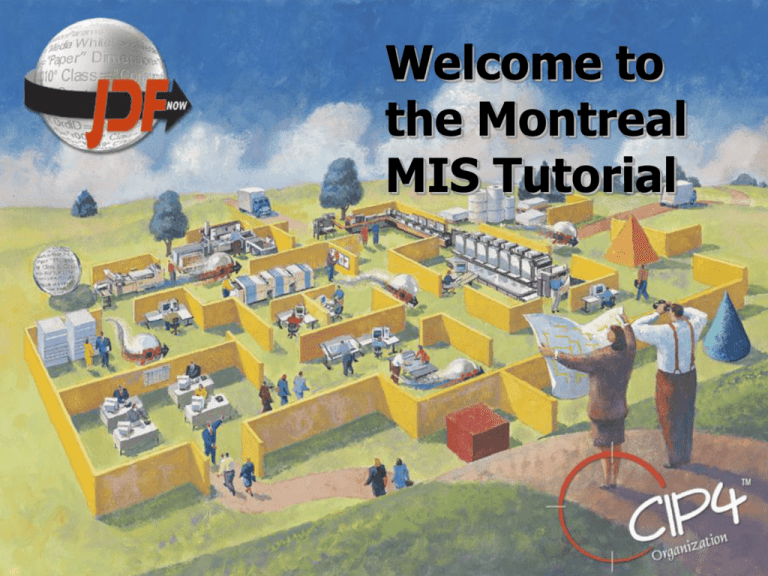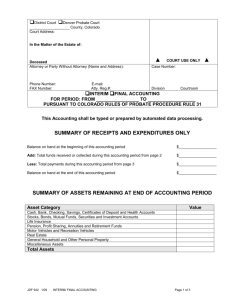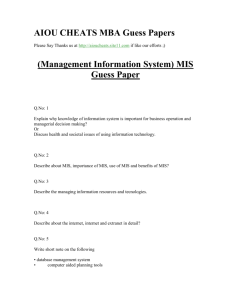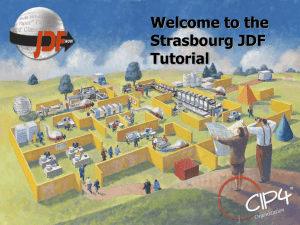MIS tutorial
advertisement

Welcome to the Montreal MIS Tutorial MIS Tutorial • • • • What is an MIS What is the MIS role in JDF Introduction Gray Boxes MIS Requirements – Job Costing CIP4 Reference Model CIP4 Reference Model Product Definition / Intent • Communication between print customer and printer • Fully “Intent-Based” • Today: mostly non-JDF • JDF used for job definition in Quotes and Orders • PrintTalk used for definition of the business transaction • CIP4 Product Definition WG CIP4 Reference Model Process Definition • MIS managed environment • MIS created initial job (ID and Ticket) • Purely “Process-Based” • MIS creates “Process” nodes or “Gray Boxes” • Production Manager expands Gray Boxes to Process nodes • JMF used for feedback MIS and JDF/JMF MIS and JDF • MIS gets customer view of job (Intent) • MIS converts Intent to Process by doing job planning, estimating and scheduling MIS and JDF • MIS creates the initial JDF ticket (Process) • MIS submits JDF ticket to production • MIS receives JMF for job tracking MIS and JDF • MIS receives JDF back after completion • MIS submits JDF to next production step Introduction to Gray Boxes Intent to Process conversion • Customer’s view of job is description of “what” to produce not “how” to produce • MIS needs to convert the “what” (Intent) into the the “how” (Process) • For some Processes MIS can create full Process definition (all Resources) • For many other Processes MIS does not have enough technical detail / knowledge • Solution: Gray Boxes Gray Boxes • For many Processes the MIS does not know: – The exact Processes required – The exact order of the Processes – The parameters of all Processes • Examples: – Pre-Press: Screening angles, Trapping params • Result: MIS cannot create valid JDF Gray Boxes • Solution (in simple words): • The MIS writes in the JDF what it knows = The Gray Box • The production system add what it needs = Expanding the Gray Box – By operator input or applying defaults • The production system informs the MIS what it has done – Using JMF Signals of type NewJDF Gray Box - Example • Example from Pre-Press Nr of pages Stripping Gray Box “PrePressPreparation” Gray Box “ImpositionPreparation” RunList content Layout Marks Gray Box “PlateMaking” Preview Plate Separations Media Gray Box - Example Gray Box - Example MIS Requirements MIS and JDF/JMF • JDF – Replacement for “Paper job ticket” • JMF and Audits – Replacement for “Shop floor data collection” Shop floor data collection • Staff time and attendance – Complete record of staff time (9 to 5) • Job costing – Complete record of actual production cost • Work in progress (WIP) – Complete record of cost of jobs in production • Equipment utilisation statistics – Complete record of machine time • Production and Non-Productive JMF vs. Audits • Audits are only available for jobs – Productive time • JMF can be used for job related time – Productive time – Up to JDF 1.3: Audits are the only accurate source of job costing data – The reason for JDF snapshots up to JMF 1.3 – From JDF 1.4: Reliable JMF Channels • JMF only way to record non-job related time – Non-Productive time Work In Progress • Value of actual costs on jobs in production – Like value of stock in warehouse • Calculated on Daily, Weekly, Monthly basis • Is used to calculate company’s profitability – Used by accountants and auditors • Must be very accurate – close enough != good enough – The reason for Audit snapshots in JMF 1.3 and Reliable JMF Channels in JMF 1.4 MIS / Production Interaction • Base+MIS-ICS Level 1 (Job Tickets Only) – Job submission – Returned JDF with Simple Audits • Base+MIS-ICS Level 2 (adds Job Tracking) – JMF Status Signals (fire and forget) – Full Audits in JDF Snapshots and Returned JDF • Base+MIS-ICS Level 3 (adds Job Costing) – JDF 1.3: JDF Snapshots in JMF Signals – JDF 1.4 (proposed): Reliable JMF Channels JMF Signals JMF Signals • Status Signals – Report Device and Job Status • Used for Job Tracking • Used for Job Costing (hours component) • Resource Signals – Report Resource Comsumption / Production • Used for job Costing (material component) • Used for Job Tracking (Plates been made?) • Events / Notifications – Report special events and milestones • Used for Errors, Job Completion reporting, Archieving, etc JMF Status Signals • JDF snapshot (1) – Up to JDF 1.3: JMF Signals a “fire and forget” and therefore “unreliable” • There is no guarantee that all Signals arrive at MIS – WIP must be accurate, therefore MIS must get complete job costing information – In JDF 1.3: JDF snapshot is only available mechanism to get accurate costs for jobs that have not yet been returned to MIS JMF Status Signals • JDF snapshot (2) – Must contain: • Process node that is executing (not complete JDF if non-spawned JDF was received) • Complete AuditPool including Audit for “this JobPhase” JMF Reliable Signals • JMF Reliable Signals – From JDF 1.4: JMF Signal channels can be made “Reliable” • To guarantee that all Signals will arrive at MIS – Signals must be acknowledged by receiver – Signals must be repeated if not acknowledged – From JDF 1.4: JMF can be used to get accurate costs for jobs that have not yet been returned to MIS JMF Status Signal JMF Resource Signals • Create JMF when: – A Resource is (partly) consumed • Media – Paper, Plates • UsageCounters – A Resource is (partly) produced • ExposedMedia – Plates • Preview • Component JMF Resource Signals Thank You







